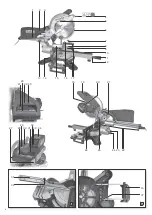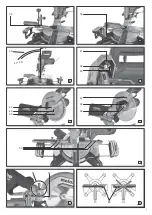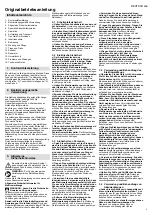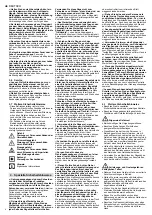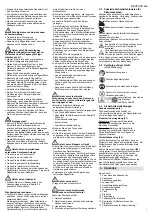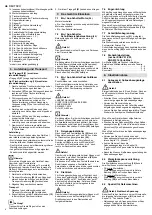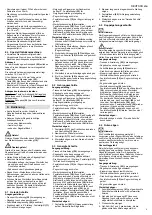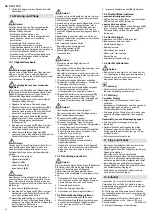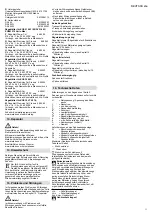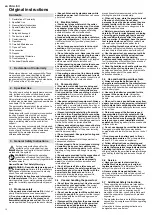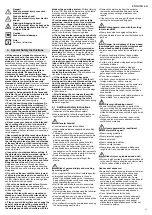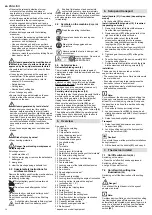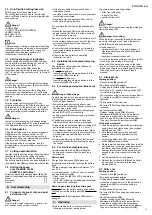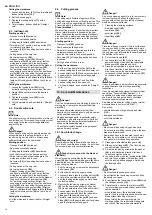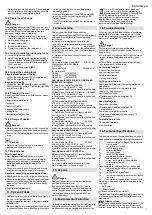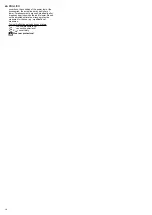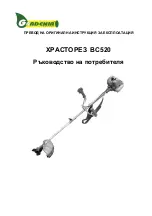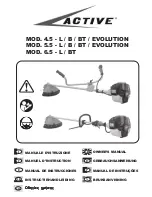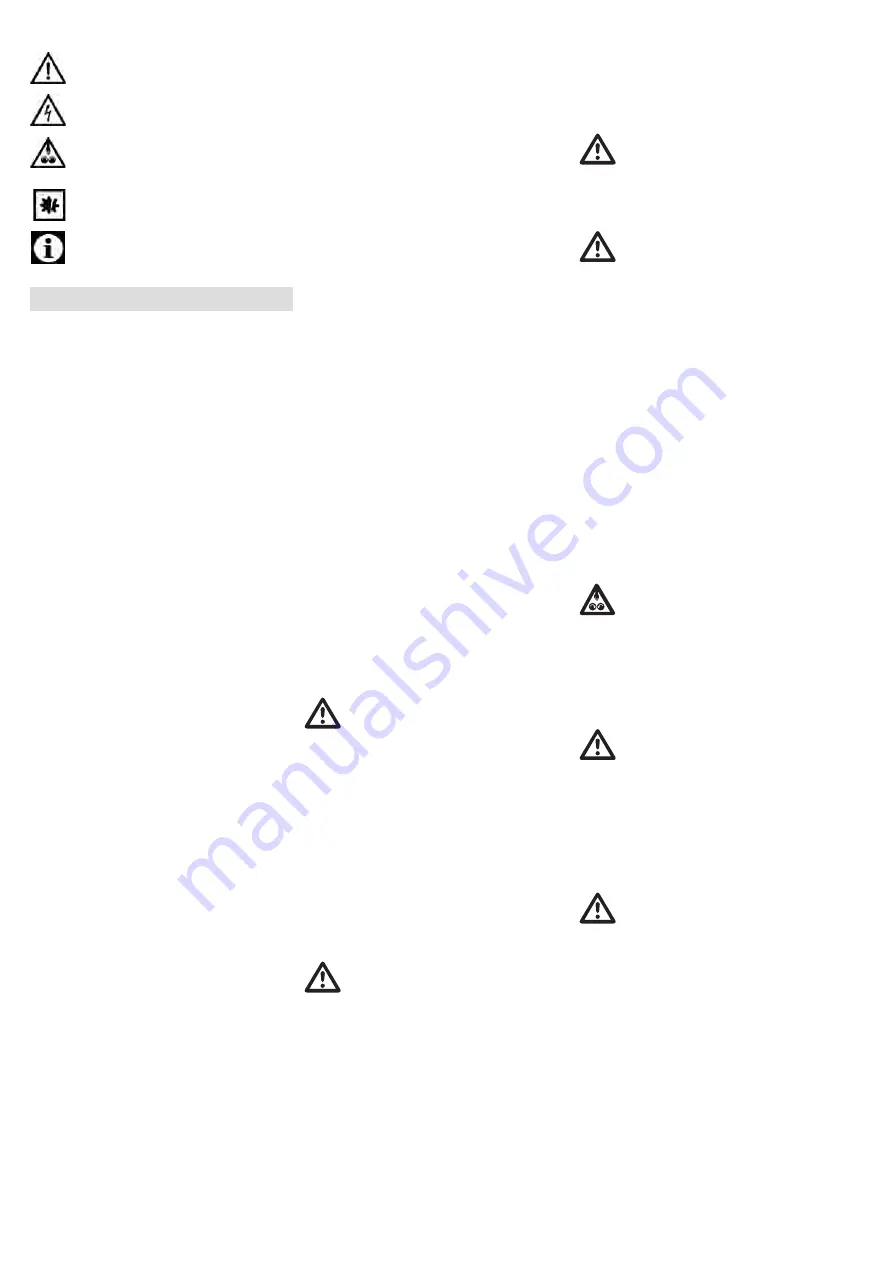
ENGLISH
en
13
Danger!
Risk of personal injury or environ-
mental damage.
Risk of electric shock!
Risk of personal injury from electric
shock.
Drawing-in/trapping hazard!
Risk of personal injury by body parts
or clothing being drawn into the ro-
tating saw blade.
Caution!
Risk of material damage.
Note:
Additional information.
a)
Mitre saws are intended to cut wood or
wood-like products, they cannot be used to
cut ferrous materials such as bars,
rods,
studs etc.
Abrasive dust causes blockage of
movable parts such as the lower guard. Sparks
from abrasive cutting will burn the lower guard,
the kerf insert and other plastic parts.
b)
Use clamps to support the workpiece
whenever possible. If supporting the
workpiece by hand, you must always keep
your hand at least 100 mm from either side of
the saw blade. Do not use this saw to cut
pieces that are too small to be securely
clamped or held by hand.
If your hand is placed
too close to the saw blade, there is an increased
risk of injury from blade contact.
c)
The workpiece must be stationary and
clamped or held against both the fence and
the table. Do not feed the workpiece into the
blade or cut "freehand" in any way.
Unrestrained or moving workpieces could be
thrown at high speeds, causing injury.
d)
Push the saw through the workpiece. Do
not pull the saw through the workpiece. To
make a cut, raise the saw head and pull it
over the workpiece without cutting. Start the
motor, press the saw head down and push
the saw through the workpiece.
Cutting on the
pull stroke is likely to cause the saw blade to
climb on top of the workpiece and violently throw
the blade assembly towards the operator.
e)
Never cross your hand over the intended
line of cutting either in front or behind the
saw blade.
Supporting the workpiece "cross
handed" i.e. holding the workpiece to the right of
the saw blade with your left hand or vice versa is
very dangerous.
f)
Never reach behind the fence when the saw
blade is rotating. Do not undercut a safety
distance of 100 mm between the hand and
the rotating saw blade (applies to both sides
of the saw blade, e.g. when removing wood
scraps).
The proximity of the spinning saw blade
to your hand may not be obvious and you may be
seriously injured.
g)
Inspect your workpiece before cutting. If
the workpiece is bowed or warped, clamp it
with the outside bowed face toward the
fence. Always make certain that there is no
gap between the workpiece, fence and table
along the line of the cut.
Bent or warped
workpieces can twist or shift and may cause
binding on the spinning saw blade while cutting.
There should be no nails or foreign objects in the
workpiece.
h)
Do not use the saw until the table is clear
of all tools, wood scraps, etc. except for the
workpiece.
Small debris or loose pieces of wood
or other objects that contact the revolving blade
can be thrown with high speed.
i)
Cut only one workpiece at a time.
Stacked
multiple workpieces cannot be adequately
clamped or braced and may bind on the blade or
shift during cutting.
j)
Ensure that the mitre saw is mounted or
placed on a level, firm work surface before
use.
A level and firm work surface reduces the
risk of the mitre saw becoming unstable.
k)
Plan your work. Every time you change the
bevel or mitre angle setting, make sure the
adjustable fence is set correctly to support
the workpiece and will not interfere with the
blade or the guarding system.
Without turning
the tool "ON" and with no workpiece on the table,
move the saw blade through a complete
simulated cut to assure there will be no
interference or danger of cutting the fence.
l)
Provide adequate support such as table
extensions, saw horses, etc. for a workpiece
that is wider or longer than the table top.
Workpieces longer or wider than the mitre saw
table can tip if not securely supported. If the cut-
off piece or workpiece tips, it can lift the lower
guard or be thrown by the spinning blade.
m)
Do not use another person as a substitute
for a table extension or as additional support.
Unstable support for the workpiece may lead to
binding of the blade. The workpiece can also shift
during the cutting operation pulling you and the
helper into the spinning blade.
n)
The cut-off piece must not be jammed or
pressed by any means against the spinning
saw blade.
If confined, i.e. using length stops,
the cut-off piece could get wedged against the
blade and thrown violently.
o)
Always use a clamp or a fixture designed
to properly support round material such as
rods or tubing.
Rods have a tendency to roll
while being cut, causing the blade to "bite" and
pull the work with your hand into the blade.
p)
Let the blade reach full speed before
contacting the workpiece.
This will reduce the
risk of the workpiece being thrown.
q)
If the workpiece or blade becomes
jammed, turn the mitre saw off. Wait for all
moving parts to stop and disconnect the plug
from the power source and/or remove the
battery pack. Then work to free the jammed
material.
Continued sawing with a jammed
workpiece could cause loss of control or damage
to the mitre saw.
r)
After finishing the cut, release the switch,
hold the saw head down and wait for the
blade to stop before removing the cut-off
piece.
Reaching with your hand near the coasting
blade is dangerous.
4.1 Additional Safety Instructions
Please also observe the special safety
instructions in the respective chapters.
Where applicable, follow the legal directives or
regulations for the prevention of accidents.
General hazards!
Consider environmental conditions:
Use suitable workpiece supports when cutting
long stock.
The saw shall only be started and operated by
persons familiar with circular saws and who are
at any time aware of the dangers associated
with the operation of such tools.
Persons under 18 years of age shall use this
tool only in the course of their vocational
training, under the supervision of an instructor.
Keep bystanders, particularly children, out of
the danger zone. Do not permit other persons to
touch the tool or power cable while it is running.
Avoid overheating of the saw teeth.
When sawing plastic, avoid melting of the
plastic.
Risk of personal injury and crushing
by moving parts!
Do not operate the tool without installed guards.
Always keep sufficient distance to the saw
blade. Use suitable feeding aids, if necessary.
Keep sufficient distance to driven components
when operating the power tool.
Wait for the saw blade to come to a complete
stop before removing cutoffs, scrap, etc. from
the work area.
Cut only workpieces of dimensions that allow for
safe and secure holding while cutting.
Use clamping devices or a vice to hold the
workpiece. It is held safer by these devices than
by your hand.
Do not attempt to stop the saw blade by pushing
the workpiece against its side.
Remove the mains plug from the socket or
remove the detachable battery pack before
carrying out any settings, maintenance or
repairs.
If the device is not in use, pull the mains plug or
remove the detachable battery pack.
Cutting hazard, even with the cutting
tool at standstill!
Wear gloves when changing cutting tools.
Store saw blade in such manner that nobody will
get hurt.
Danger from kickback of the saw head
(saw blade gets caught in the workpiece and
the saw head suddenly kicks back)!
Select a saw blade suited for the material to be
cut.
Keep the handle tight. When the saw blade
enters the workpiece, the risk of kickback is
particularly high.
Cut thin or thin-walled workpieces only with fine-
toothed saw blades.
Always use sharp saw blades. Replace
damaged saw blades immediately. There is an
increased risk of kickback if a blunt sawtooth
gets caught in the workpiece's surface.
Do not jam workpieces.
If in doubt, check workpiece for inclusion of
foreign matter (e.g. nails or screws).
Never cut several workpieces at the same time
– and also no bundles containing several
individual pieces. Risk of personal injury if
individual pieces are caught by the saw blade
uncontrolled.
When making grooves avoid lateral pressure on
the saw blade - use a clamping device.
Drawing-in/trapping hazard!
Ensure that during operation no parts of the
body or clothing can be caught and drawn in by
rotating components (
no
ties
no
gloves,
no
clothes with wide sleeves; contain long hair with
a hairnet).
Never cut workpieces to which ropes, cords,
strings, cables or wires are attached or which
contain such materials.
Hazard generated by insufficient
personal protection gear!
Wear hearing protection.
Wear protective goggles.
Wear dust mask.
Wear suitable work clothes.
Wear non-slip footwear.
Wear gloves when handling saw blades and
rough tools. Carry saw blades in a container.
Risk of injury by inhaled wood dust!
Work only with a suitable dust collector attached
to the saw. The dust extraction unit must comply
with the values stated in chapter 16..
Reduce dust exposure:
Some dust created by using this power tool may
contain chemicals known to cause cancer,
allergic reaction, respiratory disease, birth
defects or other reproductive harm. Some
examples of such substances are, lead (in paint
containing lead), additives used for wood
treatment (chromate, wood preservatives),
some wood types (such as oak or beech dust).
The risk from these exposures depends on how
long you or bystanders are being exposed.
Do not let particles enter the body.
To reduce your exposure to these chemicals:
work in a well ventilated area, and work with
approved safety equipment, such as dust
masks that are specially designed to filter out
microscopic particles.
4. Special Safety Instructions


